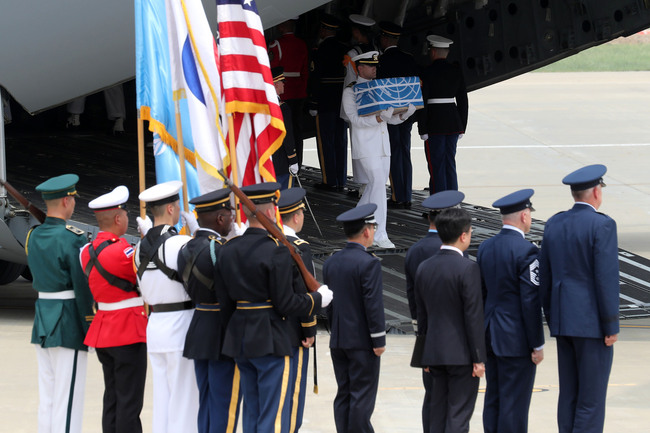 |
|
North Korea repatriated the 55 sets of the remains of US MIA/POW on July 27, the 65th anniversary of the Korean Armistice Agreement, to the US Air Force base in Osan, Gyeonggi Province. (Yonhap News)
|
Diplomatic discourse between Washington and Hanoi was far from smooth
North Korea repatriated 55 sets of US POW/MIA remains on July 27, the 65th anniversary of the signing of the armistice agreement. A “nice letter” from leader Kim Jong-un was sent from Pyongyang along with them. Four days later, the remains arrived at Hickam Air Force Base in Hawaii inside silver coffins. In Washington, US President Donald Trump expressed his thanks to Kim, saying he was “not at all surprised that you took this kind action” and adding, “I look forward to seeing you soon!” It may be the warmest exchange between the two since their North Korea-US summit in Singapore on June 12. Since North Korea’s repatriation of the US soldiers’ remains, there has been much talk about the “Vietnam model.” Some have suggested the same course seen with Vietnam in the past – starting with the repatriation of remains and leading to the lifting of sanctions and establishment of diplomatic relations – could also be applied with North Korea. Expressed within these predictions is the hope that the repatriation could inject new momentum into flagging denuclearization talks and spur on discussions toward the normalization of North Korea-US relations. The “Vietnam path” has also been touted as a blessing in the US. Secretary of State Mike Pompeo said the same “miracle” could happen for North Korea if it follows the same path taken by Vietnam. But has the path for Vietnam really been such a glorious one since its repatriation of US remains? The rough road to establish US-Vietnam relations The talks toward establishing diplomatic relations between Washington and Hanoi were a war unto themselves. The two sides were at odds from their very first meeting in May 1977. The US insisted on a resolution to the MIA issue as a precondition; the Vietnamese side countered by demanding a pledge to pay compensation for the war. It was tantamount to a demand that the US acknowledge itself as the losing side. Irked, the US Congress passed a resolution opposing aid to Vietnam. As the talks broke down, Vietnam moved in June 1978 to join Comecon, the Soviet-led Council for Mutual Economic Assistance. That December, it invaded Cambodia and undertook a military operation to oust its Khmer Rouge regime. It was under these circumstances that the issue of repatriating US soldier remains emerged as a means of getting the talks on diplomatic relations moving again. Vietnam was mired in the Cambodian morass. Massive military expenditures were compounding the economic difficulties from US economic sanctions. Hanoi finally decided to attempt dialogue toward resolving the MIA issue – effectively bowing to Washington’s demand. Five sets of remains were finally delivered to the US in Oct. 1982, in the first repatriations since the war. Subsequent talks toward diplomatic relations went entirely according to the US’s script. Washington increased its list of demands to include a withdrawal of Vietnamese forces from Cambodia, implementation of policies for reforms and openness, guarantees on foreign investment, and the release of political prisoners. It ignored Hanoi’s proposal for the lifting of economic sanctions in exchange for cooperation on the MIA and human rights issues. In 1989, Vietnam pulled out of Cambodia completely; in 1991, it permitted the establishment of an office for the handling of the MIA issue. Despite these concessions, the US continued with its offensive approach up until diplomatic relations were formed in 1995. It may have lost in its war with Vietnam, but its performance in the diplomatic talks was a resounding victory.
 |
|
US soldiers begin transporting 55 sets of the remains of US POW/MIA returned by North Korea on July 27, the 65th anniversary of the Korean Armistice Agreement, from US aircraft at Osan Air Base in Gyeonggi Province. (joint photo pool)
|







